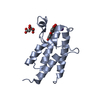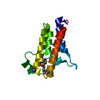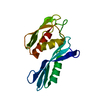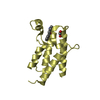[English] 日本語
 Yorodumi
Yorodumi- PDB-4l3u: Crystal structure of a DUF3571 family protein (ABAYE3784) from Ac... -
+ Open data
Open data
- Basic information
Basic information
| Entry | Database: PDB / ID: 4l3u | ||||||
|---|---|---|---|---|---|---|---|
| Title | Crystal structure of a DUF3571 family protein (ABAYE3784) from Acinetobacter baumannii AYE at 1.95 A resolution | ||||||
 Components Components | Uncharacterized protein | ||||||
 Keywords Keywords | STRUCTURAL GENOMICS / UNKNOWN FUNCTION / PF1209 family protein / DUF 3571 / Joint Center for Structural Genomics / JCSG / Protein Structure Initiative / PSI-BIOLOGY | ||||||
| Function / homology | Uncharacterised protein PF16133, DUF4844 / Protein of unknown function DUF4844 / DUF4844 superfamily / Domain of unknown function (DUF4844) / hypothetical protein mp506/mpn330, domain 1 / Up-down Bundle / Mainly Alpha / Uncharacterized protein Function and homology information Function and homology information | ||||||
| Biological species |  Acinetobacter baumannii (bacteria) Acinetobacter baumannii (bacteria) | ||||||
| Method |  X-RAY DIFFRACTION / X-RAY DIFFRACTION /  SYNCHROTRON / SYNCHROTRON /  MAD / Resolution: 1.95 Å MAD / Resolution: 1.95 Å | ||||||
 Authors Authors | Joint Center for Structural Genomics (JCSG) | ||||||
 Citation Citation |  Journal: To be published Journal: To be publishedTitle: Crystal structure of a hypothetical protein (ABAYE3784) from Acinetobacter baumannii AYE at 1.95 A resolution Authors: Joint Center for Structural Genomics (JCSG) | ||||||
| History |
|
- Structure visualization
Structure visualization
| Structure viewer | Molecule:  Molmil Molmil Jmol/JSmol Jmol/JSmol |
|---|
- Downloads & links
Downloads & links
- Download
Download
| PDBx/mmCIF format |  4l3u.cif.gz 4l3u.cif.gz | 62.5 KB | Display |  PDBx/mmCIF format PDBx/mmCIF format |
|---|---|---|---|---|
| PDB format |  pdb4l3u.ent.gz pdb4l3u.ent.gz | 45.1 KB | Display |  PDB format PDB format |
| PDBx/mmJSON format |  4l3u.json.gz 4l3u.json.gz | Tree view |  PDBx/mmJSON format PDBx/mmJSON format | |
| Others |  Other downloads Other downloads |
-Validation report
| Summary document |  4l3u_validation.pdf.gz 4l3u_validation.pdf.gz | 402.3 KB | Display |  wwPDB validaton report wwPDB validaton report |
|---|---|---|---|---|
| Full document |  4l3u_full_validation.pdf.gz 4l3u_full_validation.pdf.gz | 402.3 KB | Display | |
| Data in XML |  4l3u_validation.xml.gz 4l3u_validation.xml.gz | 7.1 KB | Display | |
| Data in CIF |  4l3u_validation.cif.gz 4l3u_validation.cif.gz | 8.9 KB | Display | |
| Arichive directory |  https://data.pdbj.org/pub/pdb/validation_reports/l3/4l3u https://data.pdbj.org/pub/pdb/validation_reports/l3/4l3u ftp://data.pdbj.org/pub/pdb/validation_reports/l3/4l3u ftp://data.pdbj.org/pub/pdb/validation_reports/l3/4l3u | HTTPS FTP |
-Related structure data
| Similar structure data | |
|---|---|
| Other databases |
- Links
Links
- Assembly
Assembly
| Deposited unit | 
| ||||||||
|---|---|---|---|---|---|---|---|---|---|
| 1 |
| ||||||||
| Unit cell |
| ||||||||
| Components on special symmetry positions |
|
- Components
Components
| #1: Protein | Mass: 15684.055 Da / Num. of mol.: 1 Source method: isolated from a genetically manipulated source Source: (gene. exp.)  Acinetobacter baumannii (bacteria) / Strain: AYE / Gene: ABAYE3784 / Plasmid: SpeedET / Production host: Acinetobacter baumannii (bacteria) / Strain: AYE / Gene: ABAYE3784 / Plasmid: SpeedET / Production host:  |
|---|---|
| #2: Chemical | ChemComp-CL / |
| #3: Water | ChemComp-HOH / |
| Has protein modification | Y |
| Sequence details | THIS CONSTRUCT WAS EXPRESSED WITH AN N-TERMINAL PURIFICATION TAG MGSDKIHHHHHHENLYFQG. THE TAG WAS ...THIS CONSTRUCT WAS EXPRESSED WITH AN N-TERMINAL PURIFICATI |
-Experimental details
-Experiment
| Experiment | Method:  X-RAY DIFFRACTION / Number of used crystals: 2 X-RAY DIFFRACTION / Number of used crystals: 2 |
|---|
- Sample preparation
Sample preparation
| Crystal |
| |||||||||||||||
|---|---|---|---|---|---|---|---|---|---|---|---|---|---|---|---|---|
| Crystal grow |
|
-Data collection
| Diffraction |
| ||||||||||||||||||||||||||||||||||||||||||||||||||||||||||||||||||||||||||||||||||||||||||||||||||||||||||||||||||||||||||||||||||||||||||||||||||||||||||||||||||||||||
|---|---|---|---|---|---|---|---|---|---|---|---|---|---|---|---|---|---|---|---|---|---|---|---|---|---|---|---|---|---|---|---|---|---|---|---|---|---|---|---|---|---|---|---|---|---|---|---|---|---|---|---|---|---|---|---|---|---|---|---|---|---|---|---|---|---|---|---|---|---|---|---|---|---|---|---|---|---|---|---|---|---|---|---|---|---|---|---|---|---|---|---|---|---|---|---|---|---|---|---|---|---|---|---|---|---|---|---|---|---|---|---|---|---|---|---|---|---|---|---|---|---|---|---|---|---|---|---|---|---|---|---|---|---|---|---|---|---|---|---|---|---|---|---|---|---|---|---|---|---|---|---|---|---|---|---|---|---|---|---|---|---|---|---|---|---|---|---|---|---|
| Diffraction source |
| ||||||||||||||||||||||||||||||||||||||||||||||||||||||||||||||||||||||||||||||||||||||||||||||||||||||||||||||||||||||||||||||||||||||||||||||||||||||||||||||||||||||||
| Detector |
| ||||||||||||||||||||||||||||||||||||||||||||||||||||||||||||||||||||||||||||||||||||||||||||||||||||||||||||||||||||||||||||||||||||||||||||||||||||||||||||||||||||||||
| Radiation |
| ||||||||||||||||||||||||||||||||||||||||||||||||||||||||||||||||||||||||||||||||||||||||||||||||||||||||||||||||||||||||||||||||||||||||||||||||||||||||||||||||||||||||
| Radiation wavelength |
| ||||||||||||||||||||||||||||||||||||||||||||||||||||||||||||||||||||||||||||||||||||||||||||||||||||||||||||||||||||||||||||||||||||||||||||||||||||||||||||||||||||||||
| Reflection twin | Operator: h,-k,-l / Fraction: 0.28 | ||||||||||||||||||||||||||||||||||||||||||||||||||||||||||||||||||||||||||||||||||||||||||||||||||||||||||||||||||||||||||||||||||||||||||||||||||||||||||||||||||||||||
| Reflection | Resolution: 1.95→47.443 Å / Num. all: 12983 / Num. obs: 12983 / % possible obs: 100 % / Redundancy: 7.3 % / Rsym value: 0.075 / Net I/σ(I): 15.9 | ||||||||||||||||||||||||||||||||||||||||||||||||||||||||||||||||||||||||||||||||||||||||||||||||||||||||||||||||||||||||||||||||||||||||||||||||||||||||||||||||||||||||
| Reflection shell | Diffraction-ID: 1,2
|
-Phasing
| Phasing | Method:  MAD MAD |
|---|
- Processing
Processing
| Software |
| ||||||||||||||||||||||||||||||||||||||||||
|---|---|---|---|---|---|---|---|---|---|---|---|---|---|---|---|---|---|---|---|---|---|---|---|---|---|---|---|---|---|---|---|---|---|---|---|---|---|---|---|---|---|---|---|
| Refinement | Method to determine structure:  MAD / Resolution: 1.95→47.443 Å / Occupancy max: 1 / Occupancy min: 0.5 / σ(F): 1.76 / Phase error: 30.5 / Stereochemistry target values: TWIN_LSQ_F MAD / Resolution: 1.95→47.443 Å / Occupancy max: 1 / Occupancy min: 0.5 / σ(F): 1.76 / Phase error: 30.5 / Stereochemistry target values: TWIN_LSQ_FDetails: 1. RIDING HYDROGENS WERE BUILT TO IMPROVE THE ANTIBUMPING RESTRAINTS BUT WERE EXCLUDED FROM F_CALC. 2. A MET-INHIBITION PROTOCOL WAS USED FOR SELENOMETHIONINE INCORPORATION DURING PROTEIN ...Details: 1. RIDING HYDROGENS WERE BUILT TO IMPROVE THE ANTIBUMPING RESTRAINTS BUT WERE EXCLUDED FROM F_CALC. 2. A MET-INHIBITION PROTOCOL WAS USED FOR SELENOMETHIONINE INCORPORATION DURING PROTEIN EXPRESSION. THE OCCUPANCY OF THE SE ATOMS IN THE MSE RESIDUES WAS REDUCED TO 0.75 FOR THE REDUCED SCATTERING POWER DUE TO PARTIAL S-MET INCORPORATION. 3.ATOM RECORD CONTAINS SUM OF TLS AND RESIDUAL B FACTORS. ANISOU RECORD CONTAINS SUM OF TLS AND RESIDUAL U FACTORS. 4. WATERS WERE EXCLUDED FROM AUTOMATIC TLS ASSIGNMENT.5. DATA ARE MEROHEDRALLY TWINNED WITH TWIN LAW (H, -K, -L).THE REFINED TWIN FRACTION WAS 0.28. THE R-FREE TEST SET REFLECTIONS WERE CHOSEN IN THIN RESOLUTION SHELLS.
| ||||||||||||||||||||||||||||||||||||||||||
| Solvent computation | Shrinkage radii: 0.9 Å / VDW probe radii: 1.11 Å / Solvent model: FLAT BULK SOLVENT MODEL | ||||||||||||||||||||||||||||||||||||||||||
| Displacement parameters | Biso max: 83.72 Å2 / Biso mean: 35.443 Å2 / Biso min: 19.38 Å2 | ||||||||||||||||||||||||||||||||||||||||||
| Refinement step | Cycle: LAST / Resolution: 1.95→47.443 Å
| ||||||||||||||||||||||||||||||||||||||||||
| Refine LS restraints |
| ||||||||||||||||||||||||||||||||||||||||||
| LS refinement shell | Refine-ID: X-RAY DIFFRACTION / Total num. of bins used: 5
| ||||||||||||||||||||||||||||||||||||||||||
| Refinement TLS params. | Method: refined / Origin x: 38.6739 Å / Origin y: 17.5633 Å / Origin z: 44.0442 Å
| ||||||||||||||||||||||||||||||||||||||||||
| Refinement TLS group | Selection details: chain 'A' and (resid 31 through 153 ) |
 Movie
Movie Controller
Controller












 PDBj
PDBj



